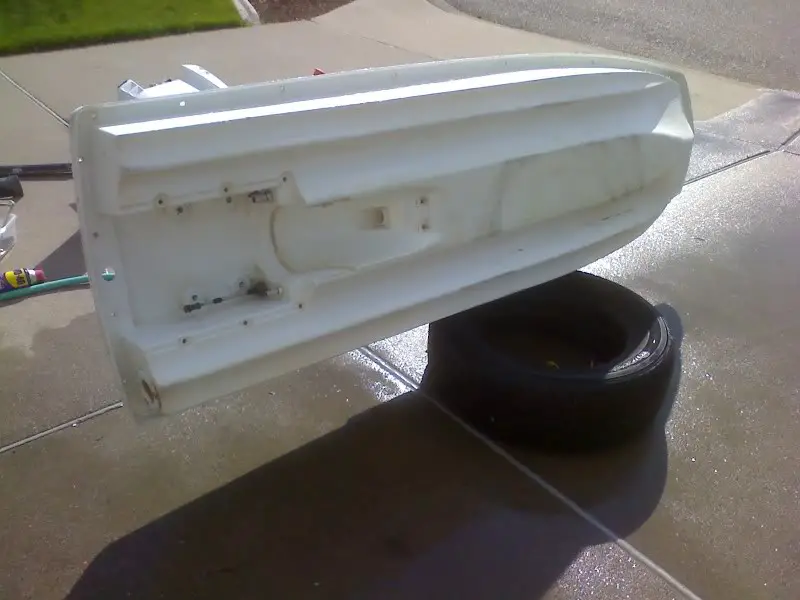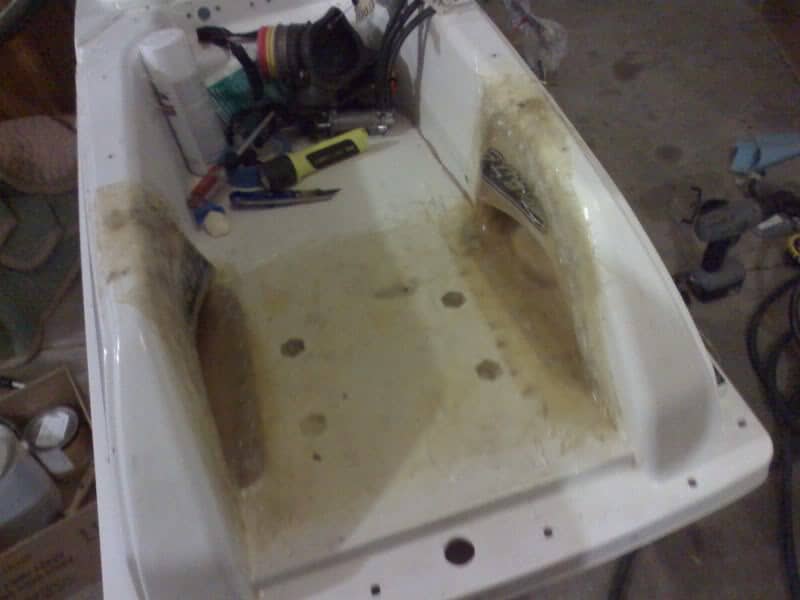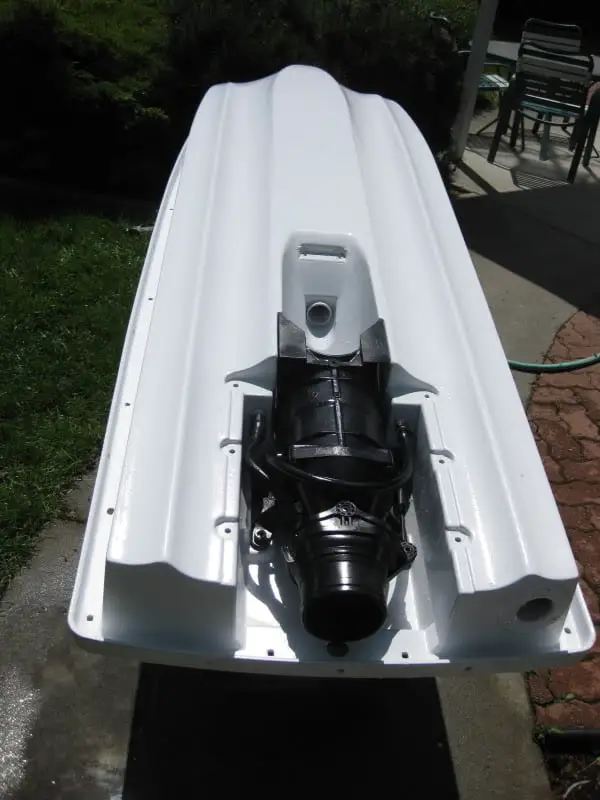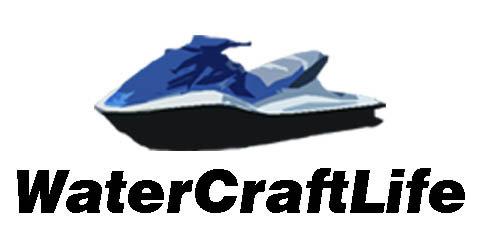
Jet Ski’s are made with lightweight fiberglass hulls. This is why they can fly through the air off of wakes and can provide the speed and maneuverability of a motorcycle on water. However, the fiberglass hull is can crack or break easily shall you come in contact with another object such as a log, dock, or beach. Even if you are a careful rider, high impact areas that get a lot of use can get scratched and also form holes. A large or even small hole in the hull of the jet ski can cause damage to the internal components of the jetski and scratches just don’t look very good. Luckily, there are tricks and tips on how to repair any damage to a jet ski hull.
How do you repair a jet ski hull? Repairing a jet ski hull is possible at home as a DIY by sanding around the hole, placing layers fiberglass mat, and then hardening fiberglass resin around the mat. Even large holes can be taken care of with only a moderate amount of effort. All of these products are available at your local hardware store.
Materials You Will Need:
- Rough & Fine Sandpaper
- Fiber Glass Mat
- Fiber Glass Resin and Hardener
- A cup for mixing with a stick
- Some cheap paintbrushes (you will throw these away)
- Acetone Remover
- Rubber Gloves
- Scissors
- Epoxy Primer
- Gel Coat
- 2 fine paintbrushes
- Personal Protection Equipment (respirator, masks, safety glasses, etc.)
The Steps To Repair A Small Hole In A Jet Ski Hull

Small holes in jetskis are fixed in much the same way big holes or cracks are fixed. The following section details the steps you will need to take for a small hole in your jet ski hull, but these steps can also be followed for a large hole or a crack. For fixing a crack in a jet ski hull, see the additional steps down below.
Make sure you have all of your materials before you start work. Also, keep in mind that fiberglass resin can come in different types (Epoxy, Vinylester, Polyester). We recommend the epoxy type of fiberglass resin because it is the strongest and is made to bond well with fiberglass.
Step 1: Cleaning & Sanding Around The Hole
The hull of the jetski is made of polyester fiberglass or a SMC (sheet molding compound). If punctured or damaged in any way, the fibrous material of the hull can grow and attach contaminants. These areas need to be cleaned first so that they are not pressed or ground into the hull.
Use soapy water than a degreaser like Super Orange to clean around the hole. This will clean away any debris or dust that maybe there and sterilize the contaminants possibly left behind.
Use the rough sandpaper first and then the fine sandpaper to sand both sides of the hull. Get the surface nice and smooth so that the bond will be clean with the resin. Dry the surface and then wipe clean with Acetone and a rag to wipe around the hole. Cleaning around the hole will also give the epoxy resin a better hold with the bonding agent of the adhesive.
Step 2: Cut The Fiberglass Mat For The Backside Of The Hole
Using the scissors, cut a piece of fiberglass mat that covers the backside of the hole. Make sure that the fiberglass mat is big enough to extend at least an inch around the hole. After you have cut out the right size piece of mat, cut out multiple pieces of fiberglass mats for your layers.
Step 3: Mix The Resin & Hardener Together
Put on the rubber gloves because the resin is extremely sticky. Using the cup and stick, mix the resin and the resin hardener together. Your resin will have instructions on the packaging with detailed instructions on how to do this. Make sure to follow the instructions carefully! Use the stick to mix the resin and hardener together. Keep in mind that the resin is now activated and will only be ready to be applied for a short amount of time, so get to work repairing the hole! Only mix the amount of resin you need to repair as it will get hard as you are working and it is better to work with fresh material.
Step 4: Apply Resin To The Hole
Use the paintbrush and apply resin directly on to the surface of the hole. Once
you have evenly coated the surface surrounding the hole, place one sheet of the
mat on the hole. Then, evenly coat more resin over the surface of the mat.
Step 5: Resin Mat Layers
After coating the first layer with resin, the second mat layer can be placed on top of it. Coat this layer with an even amount of resin, just like before. Continue this process for as many layers as you want to do.
Step 6: Allow Resin To Dry
After you have added, your mat resin layers allow them to dry. The proper amount of time needed for the resin to dry should be listed on the back of the resin container. Always feel the stiffness of the resin to make sure that it is done hardening.
Step 7: Measure The Size Of The Front Of The Hole
Use a permanent marker and trace around the hole. Then, cut the fiberglass mat layers into the same shape of your outline around the hole. This step is crucial because you want your front side(the visible side) to be flush with the rest of the hull. The outline in permanent marker helps you to cut exact pieces of fiberglass mat for your layers.
Step 8: Apply The Resin & Mat Layers To The Front Of The Hole
Mix up the resin again in the cup with your stick. Place a small amount of resin into the hole. Then, place the mat into the hole. Once the first mat layer is placed inside the hole, coat it evenly with resin. Continue the process with the rest of the layers. Let the resin dry for the right amount of time and test it for hardness with your finger to see when it is done hardening.
Step 9: Sand Down The Hardened Resin
Once the resin hardens on the outside, smooth out the surface of the patched hole with sandpaper. Again, start with the rough sandpaper then use the fine sandpaper. When you are done with the sanding of the hardened resin the patch should be seamless with the rest of the hull.
Make sure to test the integrity of the patchwork and the hardened resin by gently pressing with your finger.
Step 10: Apply Epoxy Primer and Gel Coat
One the patch is done with the layers of fiberglass mats and resin are done on each side and have been sanded down to sit seamlessly on the hull, use the fine paintbrush to apply a few coats of epoxy primer. They come in most colors, so try to find one that matches the paint job on your jet ski.
After the epoxy primer layer is dry, you can apply several gel coats. Make sure to apply evenly over the patched hole. Also, remember that the bulbous repair spot does not have to be painted or gel-coated on the inside.
How Do You Repair A Large Hole In A Jet Ski Hull?
You can follow the same steps as above for a more massive hole on the hull of a jet ski. You may want to consider more layers of the fiberglass mat to give the patch extra durability. Make sure that each layer is hardened before applying the next one. Also, test the final patch for strength with your finger.
How Can You Repair A Crack In A Jet Ski Hull?

Fixing a crack in the hull of your jet ski requires resin(epoxy) to be hardened in layers over the crack, with the fiberglass mats. The steps are similar to repairing a hole in the hull of a jet ski. If the crack does not go all of the way through the hull and is more of a deep scratch, you can just fill the hull with resin and it will patch the scratch.
Materials You Will Need:
The same materials needed to fix a hole in the hull of a jet ski are used for fixing a crack. You will also need a tool to grind out the wall of the hull around the crack. The best fix is to grind it down and then fill in the valley left from the grinding with flayers of fiberglass mat and hardened epoxy resin. The difference between the two repairs is that a crack is a one-side repair, whereas you repair both sides of the hull for a hole.
- Rough & Fine Sandpaper
- Fiber Glass Mat
- Fiber Glass Resin and Hardener
- A cup for mixing with a stick
- A cheap paintbrush(you will throw this away)
- Acetone Remover
- Rubber Gloves
- Scissors
- Epoxy Primer
- Gel Coat
- 2 fine paintbrushes
The Steps To Repair A Crack In A Jet Ski Hull
Step 1: Clean The Surface of the Jet Ski
Using Awesome! or another degreasing product, scrub down the hull of the jet ski around the crack. This will loosen and remove the greasy contaminated water stain that can build up in the crack. Do this before grinding, so you don’t grind contaminants into the plastic of the hull. Use the Acetone and a rag to wipe around the hole. This will clean away any debris or dust that maybe there. Cleaning around the hole will give you a superior bond with the resin.
Step 2: Grind Down The Crack
Use a grinder, grind out a valley down the middle of the crack that goes through almost to the top side of the hull. Then use sandpaper from rough to fine to sand the bottom of the jet ski hull. Get the surface nice and smooth so that the bond will be clean with the resin.
Step 4: Cut The Fiberglass Mat For The Backside Of The Hole
Outline the valley with a pen a half-inch out. Cut a piece of fiberglass mat that covers as much of the valley as you can so it is sitting like a V-shape. Make sure that the mat is big enough to be pressed into the valley made by the grinder in the hull and extend at least a half-inch out to the pen marks. After you have cut out the right size piece of mat, cut out multiple pieces of fiberglass mats for your layers. You will need many layers.
Step 4: Mix The Resin & Hardener Together
This step is basically the same as the one above for a hole. You still want to use gloves and use epoxy resin. There may be multiple layers of fiberglass mat needed, so you may need more resin products and a hardening agent for fixing a crack. Use the stick to mix the resin and hardener together. Keep in mind that the resin is now activated and will only be ready to be applied for a short amount of time, so repair your crack quickly!
Step 5: Apply Resin To The Hole
Use the paintbrush and apply resin up and down the length of the crack. If the length of the crack is longer than one of your fiberglass mats, only apply the resin needed for one mat at a time. Make an even coat of resin on the surface of the crack. Place one sheet of the mat on the hole then, evenly coat more resin over the surface of the mat.
Step 6: Resin Mat Layers
Since you are fixing from only one side with a crack, you will need many layers of resin and fiberglass mats to build up and hardened on top of each other. Since you have to grind down the hull to match the crack, you should get to at least that depth of the fiberglass mat layers, maybe more. After coating the first layer with resin, the second mat layer can be placed on top of it. Coat this layer with an even amount of resin, just like before. Continue this process for as many layers as needed to make the valley flush with the hull.
Step 7: Allow Resin To Dry
After you have added your mat resin layers, allow them to dry. The proper amount of time needed for the resin to dry should be listed on the back of the resin container. Always feel the stiffness of the resin to make sure that it is done hardening.
Step 8: Sand Down The Hardened Resin
Test the patch of dried resin and fiberglass patches with your finger. If the patch is stable, sand down the surface of the patch to make it smooth. Use rough sandpaper first and then fine. When you are done with the sanding of the hardened resin, the patch should be seamless with the rest of the hull.
How Do You Fix Scratches On A Jet Ski Hull?
Scratches are common for jet skis. Some become unsightly or even risk the integrity of your hull. The rocks and sand that scratch up the bottom of your jet ski are no match for sanding down the rough surface and repairing the hull and gel coat.
Materials You Will Need:

- Sandpaper (rough and fine)
- Epoxy Primer
- Gel Coat Paint
- 2 paintbrushes
The Steps To Fix Scratches On A Jet Ski Hull
Step 1: Sand Down The Scratch
Using the rough sandpaper first sand down any part of the scratch that is hanging off. Use the fine sandpaper only to smooth. The surface should remain pretty level. Sand an area larger than the scratches so that you can blend in the gel coat.
Step 2: Appy The Epoxy Primer
Using a fine paintbrush, paint the naked hull of the jet ski an even, liberal coat of primer. The layer does not have to be too thick. Remember, you still have the gel coat layer. Check the can of primer for instructions on how long the epoxy primer will need to dry.
Step 3: Apply the Gel Coat Layer

Use another fine paintbrush to paint several coats of the gel coat. Once the Gel coat layers have hardened, add some wax to the entire hull for a professional finish that will help to keep the gel coat from scratching.
Conclusion
There are two ways to fix the holes or cracks in a jetski hull: one-sided or two-sided. Two-sided is better because you are building up strong layers of epoxy and fiberglass on each side of the damage. You only need to grind down halfway or not at all for two-sided repairs. Two-sided repairs, like the one we detailed for a hole on a jet ski hull, does have more steps. A two-sided repair has to be done from both sides of the hull. It also requires that you take the jet ski apart and prep both sides for the epoxy resin. However, fixing the jet ski hull from just one side requires grinding down a valley of the hull around the crack. Then, a large number of fiberglass mats to fill in the valley left from the grinder while leaving some vulnerability to the opposite side of the repair. However, since the inner workings of the jet ski sit inside the body of the hull, it is not always possible to fix the hull with a two-sided repair.
Fixing scratches on the hull of a jet ski also deals with the final paint and clear coats of the hull. Epoxy paint and gel coat can be placed over the hole and crack fixes made with the epoxy resin and fiberglass mats. Epoxy primers come in most colors, and the gel coat adds that finish to highlight your work. It also helps to further protect the entire hull of the jet ski.
